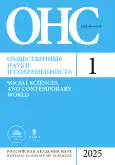Science under Sanctions: Cuba’s Experience
- Авторлар: Shugurov M.V.1
-
Мекемелер:
- Saratov State Law Academy
- Шығарылым: № 1 (2025)
- Беттер: 20-33
- Бөлім: In the Western Hemisphere
- URL: https://bakhtiniada.ru/0869-0499/article/view/294863
- DOI: https://doi.org/10.31857/S0869049925010026
- EDN: https://elibrary.ru/BIQQRG
- ID: 294863
Дәйексөз келтіру
Аннотация
An important factor in the development of Cuban science and its internationalization is cooperation with the United States, which is associated with the geographical proximity of the two countries and the coincidence of the topics of scientific research. The purpose of the article is to conceptually understand the dialectical contradiction between the complex embargo regime, reflecting the US policy towards Cuba, and the degree of intensity of scientific cooperation between these countries. The research methodology covers event analysis, comparative and historical methods, as well as a systems approach. A conceptual picture of the implementation of scientific diplomacy is presented, designed to maintain and develop scientific cooperation between the two countries despite the embargo, due to which relative stability of the scientific partnership became possible. The study made it possible to identify the main characteristics of Cuba’s experience in relation to the situation of external pressure on its science. A provision is formulated that the regime of unilateral restrictive measures against Cuban science does not imply the «cancellation» of Cuban science, as is the case with unfriendly sanctions against Russian science in 2022–2024. However, the alternation of weakening and strengthening of the embargo regime by the United States remains an unfavorable factor for the development of Cuban science.
Негізгі сөздер
Толық мәтін
Авторлар туралы
Mark Shugurov
Saratov State Law Academy
Хат алмасуға жауапты Автор.
Email: shugurovs@mail.ru
ORCID iD: 0000-0003-3604-3961
Doctor of Sciences (Philosophy), Professor of the Department of International Law
Ресей, Bldg. 3, 104, Chernyshevsky St., Saratov, 410056Әдебиет тізімі
- Anthes R., Robock A. et al. (2015) Cooperation on GPS Meteorology between the United States and Cuba. Bulletin of the American Meteorological Society, vol. 96, is. 7, pр. 1079–1088. https://doi.org/10.1175/bams-d-14-00171.1
- Arencibia-Jorge R., Corera-Álvarez E., Vega-Almeida R.L. (2017) Scientific bridges between Cuba and the United States. Revista Cubana de Informacion en Ciencias de la Salud, vol. 28, no. 2, pp. 1–9.
- Bausch D., Kourí V., Resik S. et al. (2017) The Cuba–United States Thaw: Building Bridges through Science and Global Health. American Journal of Tropical Medicine and Hygiene, vol. 96, is. 6, pp. 1267–1269. https://doi.org/10.4269/ajtmh.17-0136
- Brenner P., Haney P.J., Vanderbush W. (2002) The Confluence of Domestic and International Interests: U.S. Policy Toward Cuba, 1998–2001. International Studies Perspectives, 2002, no. 3, pp. 192–208.
- Cañete R., Goodman K.W. (2021) Cuba–US Collaboration: The Pandemic Imperative. MEDICC Review, vol. 23, no. 1, p. 89. https://doi.org/10.37757/MR2021.V23.N1.3
- Chávez-Carballo E. (2005) Carlos Finlay and Yellow Fever: Triumph over Adversity. Military Medicine, vol. 170, is. 10, pp. 881–885. https://doi.org/10.7205/milmed.170.10.881
- Demain A.L. (2009). Scientific Links with Cuba Flourish Despite US Embargo. Nature, vol. 457, is. 7233, p. 1079. https://doi.org/10.1038/4571079c
- DeWeerdt S. (2001) Embargoing Science: US Policy toward Cuba and Scientific Collaboration. Bioscience, vol. 51, is. 8, p. 612. https://doi.org/10.1641/0006- 3568(2001)051[0612:Esuptc]2.0.Co;2
- Editorial (2019) Cuba’s Biotech Boom. Nature, vol. 457, is. 7226, p. 130. https://doi.org/10.1038/457130a
- Fink G.R., Leshner A.I., Turekian V.C. (2014) Science Diplomacy with Cuba. Science, vol. 344, is. 6188, p. 1065. https://doi.org/10.1126/science.1256312
- Gulín-González J. (2021) Achievement and Challenges of the Cuban Science, Technology, and Innovation System: A Perspective on Computational Science // International Journal of Quantum Chemistry, vol. 122, is. 1: e26837. https://doi.org/10.1002/qua.26837
- Hama B. (2016) U.S. and Cuban Researchers Begin Neuroscience Collaborations. Science, vol. 351, is. 6272, pp. 458–459. https://doi.org/10.1126/science.351.6272.458
- Keck C.W. (2016) The United States and Cuba: Turning Enemies into Partners for Health. The New-England Medical Review and Journal, vol. 375, is. 16, pp. 1507–1509. https://doi.org/10.1056/NEJMp1608859
- LeoGrande W.M. (2015) A Policy Long Past Its Expiration Date: US Economic Sanctions Against Cuba/ Social Research, vol. 82, no. 4, pp. 939–966. https://doi.org/10.1353/sor.2015.0055
- Pastrana S.J., Clegg M.T. (2008) U.S.-Cuban Scientific Relations. Science, vol. 322, is. 5900, p. 345. https://doi.org/10.1126/science.1162561
- Pastrana S.J. (2015) Science in U.S.-Cuba relations. Science, vol. 348, is. 6236, p. 735. https://doi.org/10.1126/science.aaa9542
- Reardon S. (2016) Can Cuban Science Go Global? Nature, vol. 537, is. 7622, pp. 600–603. https://doi.org/10.1038/537600a
- Rodríguez-Batista A. (2022) Innovation and Education: Lessons Learned from Cuban Science, Technology and Innovation System. GECONTEC: Revista Internacional de Gestión del Conocimiento y la Tecnología, vol. 10, no. 1, pp. 1–17.
- Ronda-Pupo G.A. (2021) Cuba–U.S. Scientific Collaboration: Beyond the Embargo. PLoS One, vol. 16, is. 7: e0255106. https://doi.org/10.1371/journal.pone.0255106
- Simeón R.E. (1997) La ciencia y la tecnología en Cuba. Revista Cubana de Medicina Tropical, vol. 49, is. 3, pр. 153–160.
- Stone R. (2015) In from the Cold. Science, vol. 348, is. 6236, pp. 746–751. https://doi.org/10.1126/science.348.6236.746
- Vázquez D’Alvare M. (2019) Breves referencias al acuerdo de colaboración económica y científico-técnica. Sujeción con el acuerdo de cotitularidad. Especial reseña de la situación en Cuba. Revista De La Facultad De Derecho, no. 46, article e20194612, pp. 1–25. https://doi.org/10.22187/rfd2019n46a12
- Velázquez-Pérez L.C. (2023) Academy of Sciences of Cuba: Challenges and main innovating achievements from its advisory functions. Anales de la Academia de Ciencias de Cuba, vol. 13, no. 2, pр. 1–3.
Қосымша файлдар









